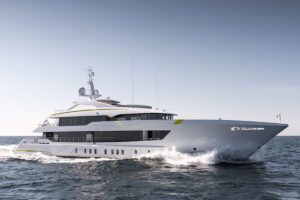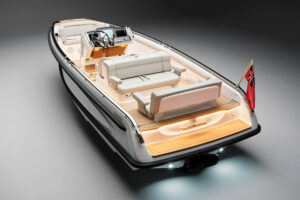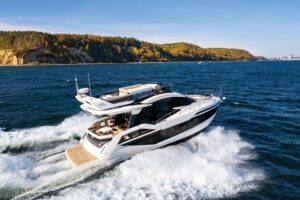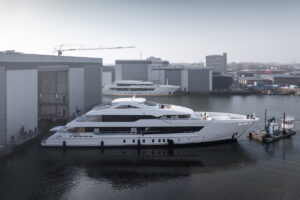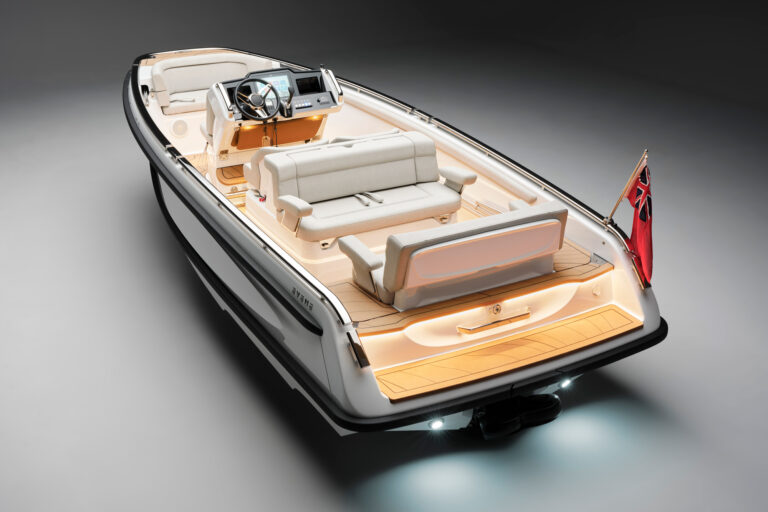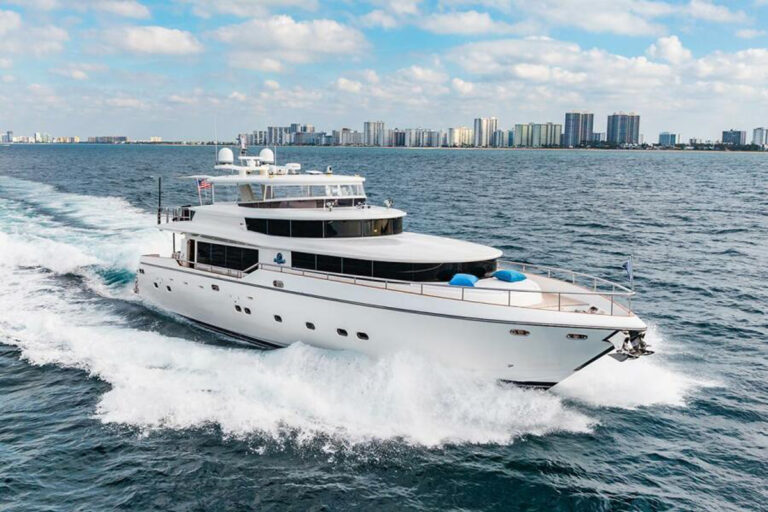I knew what to expect of the new Turner 56, Brigadoon VII, because I’d sailed Sirona, a 63-foot sloop, also from the design office of Bill Tripp, Jr. Although Sirona is heavier and less lively than her younger sibling, both of them aim for the pure pleasure of sailing, all the while wrapped in the luxury and convenience modern sailors expect of their pure cruising boats. In spite of their common heritage, Brigadoon VII surprised me.
Tacking out of the harbor in Newport, Rhode Island, in a southerly wind of 8 to 10 knots and moderate seas last fall, Brigadoon VII pranced like a blue-ribbon carriage horse. Burdened as she was by a crew of 12, her GPS still showed 7 knots over the ground. Under mainsail and 105 percent jib, she held her head at 30 degrees to the apparent wind and responded quickly and accurately to fingertip pressure on the wheel. So light, so well balanced, the steering nevertheless telegraphed the subtlest change in load at the rudder. Mechanical steering of such high quality rewards the sensitive helmsman with exquisite tactile sensations.
On starboard tack, we picked up a huge wake and surfed beyond 9 knots, headed for 10 if we’d had the presence of mind to trim the sails. After the wake dissipated, Brigadoon VII settled into a 7-knot groove, our instruments showing a true wind speed of 7 and an apparent angle of 26 degrees. During this entire episode, her steering stayed true and easy.
This level of speed and handling does not come by accident.
“It’s not about the furniture”, Tripp said when he and I discussed his goals for a comfortable high-performance sailing yacht.
Brigadoon VII belongs to Dr. Bob Morton and his wife, Kathy. Morton and his father have raced and cruised a series of like-named yachts over the past 30 years. He knew exactly what he wanted in this newest Brigadoon: great sailing first and luxury second.
“Great sailing means different things to different people”. Morton’s racing background skewed his preferences toward high speeds upwind and down, aggressively tight windward sailing angles, relatively easy sail handling and predictable response in a wide variety of conditions. And no one wants an ugly boat, no matter how grand its performance.
The Mortons’ plan to cruise and live aboard about eight months a year called for a comfortable interior, unlimited supply of water, 24/7 AC to run the modern appliances and entertainment equipment, stowage for extended cruises and room for guests.
These criteria dictated a sophisticated laminate to lighten the basic structure without sacrificing strength or durability. Rob Turner, president of Turner Yachts, describes the laminate as Kevlar fabric vacuum bagged over various densities of structural foam core in a wet-preg process. Additional layers of Kevlar reinforce areas of high stress or ones that are most likely to bear the brunt of a collision. G-10 composite panels strengthen the area around each through-hull. G-10 tubes in way of the deck fittings, such as winch mounts and genoa tracks, and lifeline stanchions, do the same.
Turner’s weight consciousness extends to the accommodations. A lot of the furniture and all of the bulkheads are lightweight composite structures, taped and vacuum bagged to the hull and deck to improve the structural integrity. Cherry veneer or white satin-finish polyurethane dresses the furniture and bulkheads, giving the illusion of a traditional stick-built interior. Tongue-and-groove ceilings, also painted a satin-finish white, line the exposed topsides, adding to the early 20th century ambience.
Essential though it may be, minding the weight is only part of the speed recipe. Managing the distribution of volume above and below the waterline and making sure the waterlines stay symmetrical as the boat heels are critically important. Brigadoon VII and subsequent Turner 56s are nearly all waterline. The 8 feet of overhang comes from a modest counter at the stern, which intersects the water right abaft the trailing edge of the rudder when the boat is static and bolt upright. The plumb stem ends in a knuckle, which hovers inches above the water, intersecting the surface at station zero.
Sighting along the topsides of the 56 reveals her wall sides. Combining the wall sides with a fine entry, a straight run, relatively gentle transition to maximum beam and broad stern sections allow the hull to maintain symmetrical waterlines at most angles of heel. What’s more, the wall sides, when they begin to submerge from the heeling force of the sail plan, displace very little water, compared with the topsides of a dramatically flared hull and more pronounced transitions stem to stern. As the 56 accelerates toward a speed/length ratio of 1.34 and beyond, the wall sides and symmetrical waterlines lift the forward sections out of the water. Brigadoon does not dig a hole in the water between a rising quarter wave and bow wave. Her wave pattern forms a straight line, which is her way of laughing at the displacement-hull formula of 1.34 times the square root of waterline length.
Brigadoon VII‘s lifting keel-hydraulically operated to reduce draft from 12 feet, 6 inches to 7 feet, 6 inches-is a silicon-bronze hydrodynamic foil of short chord, capped at the tip by a large lead-antimony ballast bulb. The keel sweeps aft a few degrees, and the leading edge of ballast bulb is flush with the leading edge of the keel. High-aspect keels have a reputation for being easily stalled, but Brigadoon didn’t show any signs of this. In fact, maintaining her groove required only average skill and attention. I’m sure the deep balanced rudder contributes to her excellent behavior.
The keel also has influenced the arrangement plan, but in a positive way. The keel lives in a trunk located between stations 4 and 5 immediately forward of amidships. It spans the distance between the bottom of the hull and the deck, tying the two together and increasing the stiffness of the whole structure. This is the perfect spot for the galley, directly in line with the boat’s pitching axis-so there it is in a snug U-shape between the keel trunk and the port side of the hull. The motion here, even in a serious seaway, will be gentle, allowing the cook to prepare nourishing and tasty meals at sea. I love this galley. Stowage?-I counted 10 cabinet doors in the galley. The spice rack slides out of a slot on the right-hand side of the stove, and a serving tray resides in a similar slot on the left side. A pass-through in the backrest of the dinette expedites serving and clean-up. You get to it by removing a section of the cushion and folding down a sizeable panel.
Light from the big windows in the raised saloon washes the common areas amidships, making the cherry and painted surfaces glow with “welcome aboard. The effect is diametrically opposed to the one you’d get with a mostly mahogany interior, but it is no less elegant. The Mortons specified a raised saloon for Brigadoon VII because they had enjoyed the view and light quality of the saloon aboard a motoryacht during their honeymoon. I’m not wild about the effect a raised saloon has on the boat’s exterior lines, but I certainly love what it does to the interior. Morning coffee at the dinette, the newspaper spread before me on the table, the scenes around the anchorage playing on the windows of the house make heaven seem irrelevant.
A carbon fiber swept spreader rig reduces weight aloft, enhancing the 56’s stability. Non-overlapping headsails and chain plates located all the way outboard make possible sailing without running backstays, further simplifying operation of the boat whether the Mortons are cruising or racing. The headsail furling system is recessed into the foredeck, reducing clutter on deck and allowing a deck-sweeping genoa for racing.
Brigadoon VII, and, in a smaller way, Bill Tripp owe their success to the Mortons and Turner Yachts’ fine execution of their ideas. If you look closely enough below, you’ll discover small irregularities in the joinery, but that will improve as the builder’s staff matures. On the other hand, this boat isn’t about the furniture, is it?.
Contact: Turner Yachts, (905) 934-8300; fax (905) 934-3100; www.turneryachts.com.

